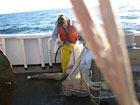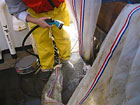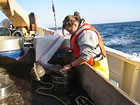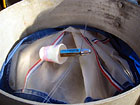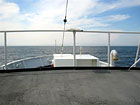

 | |||||||
|
|
Journals 2004/2005Aimee Gauthier
August 22, 2004 - Day 7 This was my last sunrise for the year on the open sea. Unfortunately it was too overcast to see it. We are currently off the coast of Nantucket by about 35 miles or so. In this water there is something strange. It is called Gamarid amphopods. They are squirmy and gross. They are approximately 5 mm in length and they CLING to the nets. So to attempt to spray them out is next to impossible. It took me over 20 minutes to complete the nets. They are highly predatory and that is why they cling to the nets. They eat fish larvae. In transferring the sample into the preservation jar you need to do it swiftly because if you do not, the fish larvae are the last meal for these feisty amphopods. Although they are predators, they make a great meal for some species fish and skates. So what goes around comes around- I guess? I had to spray down the nets ... (Click on thumbnail below for full version pop-up) Still spraying down the nets... (Click on thumbnail below for full version pop-up) And now the final net... (Click on thumbnail below for full version pop-up) We are moving to our next station, which is moving farther east from Nantucket. And in the mean time, John explained to me the reasons for the flow meters on the nets. If the sample was analyzed and they counted 200 salps and a little amount of phytoplankton but the flow meter was not present they do not know how much water went through the nets, therefore they do not know the actual length of the tow. This way with the meter the scientist use a mathematical formula and they plug in the difference in rate of the flow meter, with the angle of the wire and then look at the amount of organisms and there is a standard to go by. We did not want false reads on the flow meter because they are important in determining the amount of water that goes into the nets, so I had to put a paper cup on the flow meter. This method seems primitive but as the nets were lowered into the water the wind would move the flow meter in give us a false reading, and ultimately alter the data. (Click on thumbnail below for full version pop-up) I also got the opportunity to sit at the bow of the ship. It was simply beautiful. The water was calm and we were just coasting along. It was nice to see where we were going as opposed to were we had been. (Click on thumbnail below for full version pop-up) August 22, 2004 - Day 7 This is the last watch of the cruise for me. We are still over 120 miles off the coast of Nantucket. We seem to be doing our last few stations in a circular pattern, but the more samples that we do, the more data they have to analyze. I just completed our last changing of the ethanol in the Zoogen samples. We needed to change out the sample after a 24 hour period and put new ethanol into the sample. I noticed that the ethanol when discarding it was rather oily. John explained to me that the ethanol, although it preserves the specimen's DNA better it takes the oil and bodily fluids out of the organism which will shrink the organism. Return to Journals Index |
||||||
